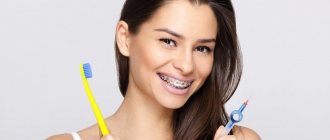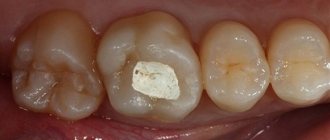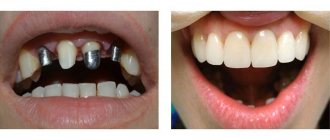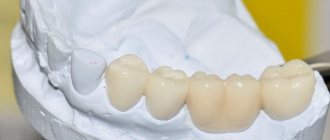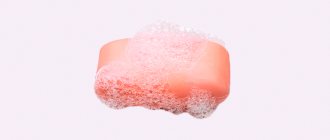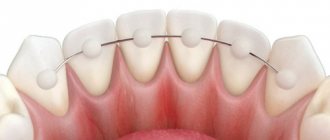5758
Poor oral care is one of the main factors contributing to the development of periodontal and dental diseases.
Any orthodontic devices, including mouthguards, make it difficult to keep teeth clean and, therefore, increase the risk of disease. How to properly care for your mouth guard to minimize it?
Mandatory daily procedures
There are sports mouth guards, designed to protect teeth during sports, and orthodontic mouth guards, used to correct dental anomalies and stabilize their results.
The latest models include aligners, elastopositioners (correctors), retention and night guards (for bruxism). Caring for them has a lot in common, since they are all made of polymers. But there are also features due to differences in functionality and mode of use.
Heavily soiled trays have white spots. This is dried saliva and bacteria. Microorganisms in the mouth easily transfer from teeth to orthodontic devices and back. Therefore, keeping your orthodontic appliances clean is no less important than keeping your teeth clean.
All mouthguards, with the exception of sports models, must be washed daily, at least once a day. They are removed during meals. Before putting them back on, you should brush your teeth or at least rinse your mouth.
Sports products are washed after each use.
The mouth guard should be stored in a special case that protects it from damage by pets, as well as bacterial and general contamination. The case must be ventilated. It also needs to be washed periodically (at least once a week).
The following products can be used for cleaning:
- mild soap;
- bleach;
- means for cleaning dentures;
- toothpaste.
In the absence of all this, you can temporarily use baking soda.
Important! The water should be at room temperature or warm, but not hot, and especially not boiling water. This requirement must be observed especially in relation to sports mouth guards, the inner layer of which is made of thermoplastic polymers.
The material used in the manufacture of an individual sports mouth guard and the service life of the product.
Head here to take a closer look at the features of the Air Align mouth guard.
At this address you will find the characteristics of the VSD mouth guard.
Where to buy a mouthguard for teeth?
Standard mouthguards for protecting teeth are sold in sporting goods stores; they are inexpensive and available to absolutely everyone. However, many patients ask where to order a dental guard online? There are special websites that offer various equipment and equipment for sports. According to reviews, dental guards from Aliexpress are not always of good quality.
Therefore, in order to become the owner of an individual mouthguard for any purpose, you need to contact the clinic, since they are made from personal impressions in dental laboratories or in production. In addition, the doctor will tell you how much a dental guard costs and how to use it correctly.
Where can I buy standard-sized dental trays for the treatment of bruxism or thermoplastic ones for remineralization or teeth whitening procedures? They are sold in pharmacies. But before purchasing such mouth guards, it is also necessary to consult a dentist in order to avoid the negative consequences of their incorrect use.
Cleaning steps
As already noted, the mouth guard needs to be cleaned at least once a day. It is best to do this in the evening so that during the night the teeth do not come into contact with the contaminated structure and are not subject to colonization by bacteria that have accumulated on the polymer surface during the day. The cleaning technology depends on the product used.
Mild soap
You can use any detergent in gel form - for washing dishes or hands. The cleaning procedure is simple, you need:
- apply a little gel to the mouth guard;
- moisten the brush with water;
- clean all surfaces;
- rinse the product with water so that no detergent remains on it;
- dry with a towel.
One of the criteria for the purity of a polymer product is the absence of mucous on it.
Bleach
Bleach is a very effective cleaning agent. The standard solution concentration is 1:10 (1 part of bleach is 10 parts of water). The solution is prepared in a small container. The operation is performed with rubber gloves.
Procedure:
- preparation of the solution - diluting the solvent with water in a ratio of 1 to 10.
- placing the mouthguard in the solution and keeping it there for about 10 minutes;
- removing the product from the solution , washing off the bleach with running water and mild soap, drying with a towel.
Tablets or powder for dentures
In this case, you must act strictly according to the instructions for the product. This order is usually prescribed.
- Dissolving the tablet or powder in the volume of water taken according to the instructions.
- Place the tray in the solution for 10-15 minutes.
- Removal and rinsing with water.
Toothpaste and brush
Toothpaste is recommended for cleaning all aligners except aligners. The latter are thin transparent products that can become rough from toothpaste.
This negatively affects the appearance and promotes the attachment of bacteria to the surface. Some experts argue that mouth guards should not be cleaned with toothpaste at all, but the majority still speak out in favor of this operation.
For cleaning, you need to use a separate brush with stiffer bristles than the one used for brushing your teeth . Experts also do not have a common opinion on the issue of choosing toothpastes. Some believe that mouthguards can be cleaned with any toothpaste, while others are of the opinion that it is better not to use highly abrasive compounds.
The cleaning operation is performed in the following sequence. Toothpaste is applied to a damp brush or mouth guard and the entire surface is brushed. After which it is washed and placed in the mouth or dried and placed in a case.
Baking soda
A mixture is prepared from baking soda and water in a 1:1 ratio, which is applied for 5-10 minutes, after which it is washed off with water.
In addition to manual cleaning, professional cleaning methods using ultrasound are also used. You can buy a special Blazer ultrasonic device.
Varieties
All mouthguards for adult patients are made of high-tech plastic or silicone. They are usually divided into three types:
- Standard (standard) models that are produced without taking into account the structural features of the jaw of a particular patient. They cost much less, but can cause discomfort during operation.
- Individual products. They are created based on a cast of the jaw. They are extremely convenient and guarantee quick results.
- Thermoplastic. Such mouthguards take the shape of the jaw after installation. This method requires constant monitoring by the attending physician, otherwise there is a risk of incorrect fixation. This can lead to severe discomfort. It is also important to pay more attention to the installation of such mouth guards for young children, this is due to the fact that their jaw is still poorly formed.
Mouthguards are usually divided into several more varieties, taking into account what time of day they need to be worn. Night guards have a fixing and preventive effect; they are prescribed after treatment with braces. Another option is 24-hour mouth guards. They should be worn for at least 20 hours a day. Their main purpose is to straighten teeth and correct minor malocclusions.
The need for sterilization
Sterilization is necessary to destroy pathogenic microorganisms that remain after standard cleaning. It effectively destroys bacteria, but does not replace physical cleaning, but complements it.
Thermal (autoclave) sterilization is contraindicated for the vast majority of models, although there are some manufacturers whose products can be subjected to autoclave sterilization. This is specifically stated in the specifications.
The main method of disinfection is chemical sterilization. This is often done using sodium hypochlorite , which is added to bleach and denture cleaner. At their core, the cleaning methods described above using bleach and denture care products are sterilization.
The sterilization procedure is indicated in the instructions for the product. It usually consists of preparing a sterilizing solution and placing the tray in there for about 10 minutes. It is best to do this every day, but 1-2 times a week is acceptable.
You should know! The prepared sterilizing solution remains active for 7-10 days, so you don’t have to prepare a new one every time.
Tactics of bite correction with Invisalign teen aligners and treatment time.
This publication provides a detailed review of Clear Correct aligners.
Here https://zubovv.ru/ortodontiya/kapyi/splint-terapii-v-stomatologii.html all the most important things about splint therapy.
What else do you need to know
- Do not chew the mouthguard, this will significantly shorten its service life and make it fit worse.
- Do not drink anything other than water during use. Especially avoid drinks containing sugar, as well as protein shakes. If you drink anything other than water, remove the mouth guard.
- Take your mouthguard with you when you go to the dentist for a checkup. Show him your model and ask his opinion on how it fits.
Based on materials from Jiu Jitsu Magazine
Large range of protection for martial arts:
- Boxing mouthguards;
- Boxing wraps;
- Groin protection.
Terms of use
The time to use a mouthguard depends on its type (sports or orthodontic), material and care.
Sports mouthguards are used periodically, only during sports activities. Their service life is affected by the duration and intensity of sports competitions and training. A high-quality, well-fitted protective design can last about a year or even more. But with intensive use, it can wear out in a few months.
Orthodontic structures are worn for a certain period of time, which depends on the type and degree of the anomaly.
Each aligner included in the kit is worn for 2 to 4 weeks. Therefore, they do not have time to wear out to a bad condition.
Elastic positioners, retention and night guards are designed to last longer. The entire course of treatment is carried out in one instance and ranges from several months to 1-1.5 years.
During routine visits to the doctor, he monitors the condition of the mouthguard, and if it has reached a critical level, he replaces the model with a new one.
Actions that reduce service life:
- Poor care.
- The habit of chewing them.
- Poor fit of the sports model.
- Cleaning using abrasive pastes.
- The use of aggressive liquids, such as vinegar.
- Storage at high temperatures (on a radiator, car dashboard and other warm places).
- Boiling.
Washing with clothes will also not benefit the elastic polymer.
In the video, the specialist will supplement the information presented above.
Hygiene benefits of mouthguard treatment
The mouth guard is a non-capricious system, and unlike the braces system, it does not require a diet or serious restrictions in the consumption of any food products due to the fact that the mouth guard is removed during meals.
Also, the patient will not have to purchase and use an irrigator, single-beam brushes, interdental brushes and other quite expensive devices.
Orthodontist Irina Butorina offers her patients the most modern methods of orthodontic treatment. The effectiveness of teeth straightening technology with aligners today is beyond doubt. You can now appreciate its benefits without extra costs. We invite you to undergo an examination and orthodontic treatment with the experienced doctor Irina Butorina.
Reviews
Like any other thing, the service life of a mouthguard depends very much on the quality of care. If you happen to wear a sports or orthodontic mouthguard, tell us how you looked after it, how many years did it last?
The comment form is located at the bottom of this page.
If you find an error, please select a piece of text and press Ctrl+Enter.
Tags mouth guards Care
Did you like the article? stay tuned
No comments yet
Brushing your teeth and caring for your mouth while wearing aligners
Brushing teeth and oral hygiene | Aligners |
| Difficulty with hygiene | No |
| The need to brush your teeth after every meal | no (rinse) |
| Brushing teeth as usual without additional equipment | Yes |
| Possibility of using dental floss for cleaning | yes (optional) |
| Possibility to use toothpicks | yes (optional) |
| Using special toothbrushes | No |
| The need to update your toothbrushes | Standard |
Aligners are an invisible (unnoticeable) way to correct your bite. But we all must understand that aligners will only be invisible on the teeth when the teeth themselves are clean and the oral cavity is well-groomed.

